Is it art or copying? —
 Cranky Media Guy
Cranky Media Guy sent me
an interesting link to an article published last December in the New York Times about the artist
Richard Prince. He's described as a pioneer of
"appropriation art." What this means is that Prince takes photographs of other photographer's photographs, and then displays them as his own. For instance, he had an exhibit at the Guggenheim about cowboys, which basically consisted of photographs of Marlboro ads. The guy who actually took the images for the Marlboro ads, the photographer Jim Krantz, visited the exhibit and was like, "Hang on, those are my photographs!"
In the thumbnail, you can see Krantz's original photograph on top, and Prince's rephotograph of it on the bottom.
Prince doesn't try to hide what he does. And art critics love his work. According to the NY Times: "one of the Marlboro pictures set an auction record for a photograph in 2005, selling for $1.2 million." That's good money for a photograph of someone else's photograph.
It raises the question, is this really art, or is it just mindless copying? To which the answer, as always, is that art is whatever art critics say is art (and whatever the courts allow artists to get away with).
Generally I take a very liberal attitude about copyright. I think it's necessary that people are allowed to copy works of art in order to be able to comment upon them, criticize them, or develop them into something new and different. But what Prince is doing looks more to me like glorified scrapbooking than creating original art.
It also reminds me of the scam that art museums try to use to establish perpetual copyright to the works in their collection. They take photographs of all the paintings they own that have passed into public domain. Then they claim that, while the original might be in the public domain, their picture of it is copyrighted -- and then they demand exorbitant fees from anyone who wants to reproduce it.

 Product placement has reached the TV news. On the desk in front of the anchors of Las Vegas's Fox 5 TV news sit two cups of McDonald's iced coffee. McDonald's is paying for the coffee to be there. But the best part: it's not real coffee. It's just a plastic simulation of iced coffee. From the Las Vegas Sun:
Product placement has reached the TV news. On the desk in front of the anchors of Las Vegas's Fox 5 TV news sit two cups of McDonald's iced coffee. McDonald's is paying for the coffee to be there. But the best part: it's not real coffee. It's just a plastic simulation of iced coffee. From the Las Vegas Sun: Just as popular recently as the Office Freakout video (posted about below), has been a video titled "Wii Fit - Why You Should Buy It For Your Girlfriend." It's one minute of a girl in her underwear working out with the Nintendo Wii Fit as her boyfriend ogles her.
Just as popular recently as the Office Freakout video (posted about below), has been a video titled "Wii Fit - Why You Should Buy It For Your Girlfriend." It's one minute of a girl in her underwear working out with the Nintendo Wii Fit as her boyfriend ogles her.  The models in Dove's "Real Beauty" campaign (whose tagline was "we believe real beauty comes in many shapes, sizes and ages") may have benefitted from some "digital plastic surgery." From The Telegraph:
The models in Dove's "Real Beauty" campaign (whose tagline was "we believe real beauty comes in many shapes, sizes and ages") may have benefitted from some "digital plastic surgery." From The Telegraph:
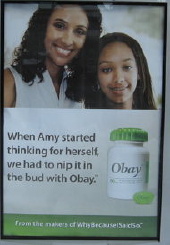
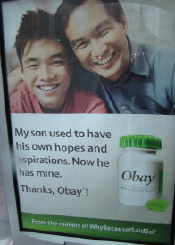
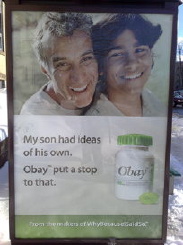



 Cranky Media Guy sent me an interesting link to an article published last December in the New York Times about the artist Richard Prince. He's described as a pioneer of "appropriation art." What this means is that Prince takes photographs of other photographer's photographs, and then displays them as his own. For instance, he had an exhibit at the Guggenheim about cowboys, which basically consisted of photographs of Marlboro ads. The guy who actually took the images for the Marlboro ads, the photographer Jim Krantz, visited the exhibit and was like, "Hang on, those are my photographs!"
Cranky Media Guy sent me an interesting link to an article published last December in the New York Times about the artist Richard Prince. He's described as a pioneer of "appropriation art." What this means is that Prince takes photographs of other photographer's photographs, and then displays them as his own. For instance, he had an exhibit at the Guggenheim about cowboys, which basically consisted of photographs of Marlboro ads. The guy who actually took the images for the Marlboro ads, the photographer Jim Krantz, visited the exhibit and was like, "Hang on, those are my photographs!"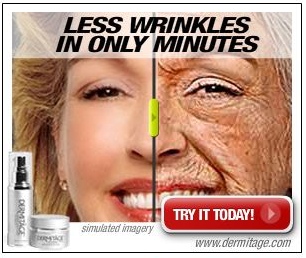 This ad, which has been running on digg, seems like a particularly egregious example of false advertising. Of course, if anyone would challenge the company in court they could say, "we never actually claimed our product could make an old lady look like a young model. That picture, as the disclaimer indicates, is merely simulated imagery."
This ad, which has been running on digg, seems like a particularly egregious example of false advertising. Of course, if anyone would challenge the company in court they could say, "we never actually claimed our product could make an old lady look like a young model. That picture, as the disclaimer indicates, is merely simulated imagery."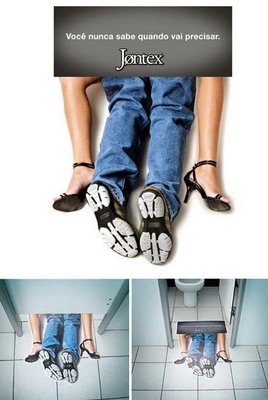 The image to the right shows what is supposedly a guerrilla marketing campaign by Jontex, a Brazilian brand of condoms owned by Johnson & Johnson. The campaign involves a cardboard cutout that can be positioned beneath the door of a bathroom stall. The Brazilian phrase translates to, "You do not know when it can be necessary."
The image to the right shows what is supposedly a guerrilla marketing campaign by Jontex, a Brazilian brand of condoms owned by Johnson & Johnson. The campaign involves a cardboard cutout that can be positioned beneath the door of a bathroom stall. The Brazilian phrase translates to, "You do not know when it can be necessary."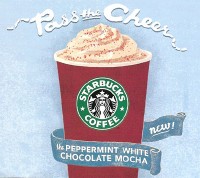 If you've been to Starbucks in the past week or so, you've been at risk of finding yourself trapped in a "cheer chain." What this means is that the person in line in front of you pays for your drink, and in return you're supposed to pay for the drink of the person behind you. This goes on and on, ad nauseam. The Associated Press reported on one cheer chain that totaled 1,013 customers.
If you've been to Starbucks in the past week or so, you've been at risk of finding yourself trapped in a "cheer chain." What this means is that the person in line in front of you pays for your drink, and in return you're supposed to pay for the drink of the person behind you. This goes on and on, ad nauseam. The Associated Press reported on one cheer chain that totaled 1,013 customers.
 Here's another example of a retailer creating a misleading display for their product. It's not technically a lie, but it certainly could confuse a shopper who didn't pay close attention. The image has been circulating around the internet recently. Unfortunately, I can't remember where I first saw it.
Here's another example of a retailer creating a misleading display for their product. It's not technically a lie, but it certainly could confuse a shopper who didn't pay close attention. The image has been circulating around the internet recently. Unfortunately, I can't remember where I first saw it.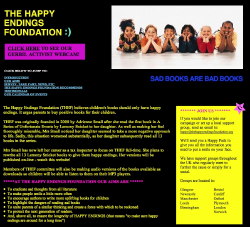 The Happy Endings Foundation believes that all children's books should have happy endings. Those that don't should be banned.
The Happy Endings Foundation believes that all children's books should have happy endings. Those that don't should be banned.